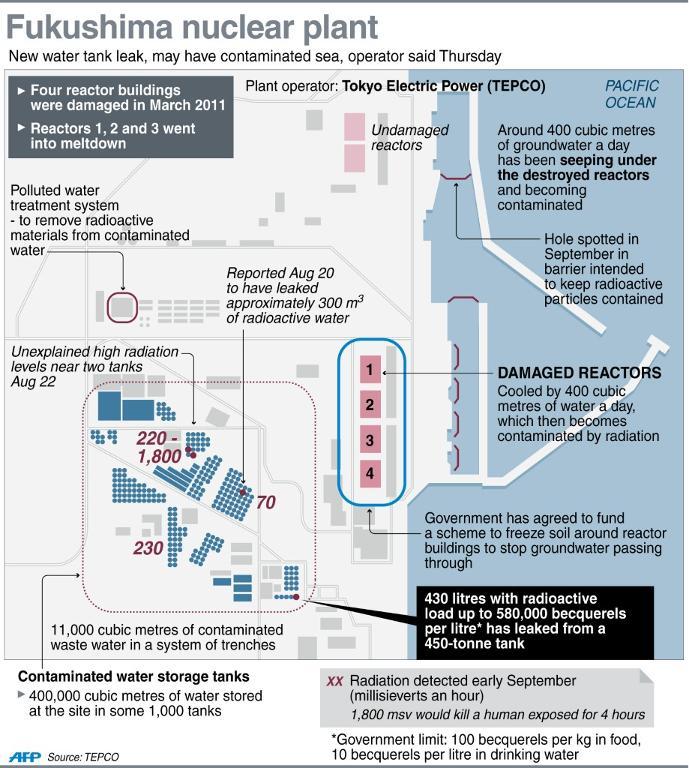- One of the Fukushima tanks receiving low-contamination rainwater has overflowed. Most of the water seems to have fallen inside the foot-high coffer dam surrounding the five tank group. But, because the tanks are located on a slight incline and the problem one is the last in line, some of the overflow fell outside the dam. Tepco tests on the water inside the dam revealed about 200,000 Becquerels per liter of Beta-emitting activity. Cesium-134 was at 18 Bq/liter and Cesium-137 was at 54 Bq/liter, both below the national limit for release. The tank is located about 200 meters from the sea.

It is estimated that the released wastewater measured about 430 liters. Because a small drainage ditch is near the spill and connects to a main drainage culvert, Tepco could not say that some of the lost water did not make it to the sea. http://www.tepco.co.jp/en/press/corp-com/release/2013/1231162_5130.html — http://www3.nhk.or.jp/nhkworld/english/news/20131003_18.html
- On Thursday, Tepco said some of the most-recent leak probably made it to the sea. Senior TEPCO official Masayuki Ono said, “We think contaminated water has entered the sea.” Samples taken from the ditch leading to the sea show diminishing contamination levels the further the trough gets from the tank that overflowed. Adjacent to the tank, the reading was 15,000 Becquerels per liter of “all Beta” activity. At a point near the ditch’s outlet, the reading was 840 Bq/liter. Tepco also said the tank that overflowed did not have a completely bolted-down cover on it. Many of the bolts were not tightened. Fukushima Prefecture drew their own ditch outlet samples on Thursday, expecting the results to be available later today. http://the-japan-news.com/news/article/0000697762
- The F. Daiichi rainwater spill earlier this week had higher activity than previously reported. Tepco posted a handout on it. Tepco initially said that the concentration of “all-Beta” activity was 160 Becquerels per liter, based on what was found in the rainwater buildup in the main storage tank’s coffer dams during the recent typhoon. However, testing of the water inside the notch tank shows a concentration of 390 Bq/liter. Prior news reports mistakenly indicated that the transferred rainwater was intended for a storage tank, but was mistakenly sent to one already full. Actually, the water was erroneously pumped to a relatively small “notch tank” by mistake. From the Tepco handout, it appears the tank has a capacity of about 5 tons. It was surrounded by a small temporary retaining dam, standing perhaps 20 centimeters high. Once the notch tank was full of the very-low contaminated water, it overflowed and quickly filled the temporary dam to overflowing. The estimated four tons that spilled out of the dam quickly soaked into the surrounding soil. http://photo.tepco.co.jp/en/date/2013/201310-e/131001-01e.html — http://photo.tepco.co.jp/en/date/2013/201310-e/131001-01e.html
- Fukushima Prefecture will run their own testing on the sea around F. Daiichi. Speaking at an emergency meeting of officials, Governor Yuhei Sato said they have done this because of the contaminated tank spills reported this week. Sato now questions the honesty of Tepco’s president who promised wastewater containment would be given the highest priority. Thus, he feels Tepco can no longer be trusted and the Prefecture feels compelled to run their own seawater testing. Sato added that the heads of other nearby prefectures tell him they are concerned about what is happening and wanted Fukushima to do whatever is necessary to stop leakage of radioactive water into the Pacific Ocean. The first sampling occurred today at the outlet of the affected drainage ditch to the sea. http://www3.nhk.or.jp/nhkworld/english/news/20131003_19.html
- The Nuclear Regulation Authority admonished Tepco for the current wastewater problems at F. Daiichi. The NRA’s Chief Secretary Katsuhiko Ikeda summoned Tepco President Naomi Hirose, tore into him for “rudimentary mistakes” and said the company’s management of their problems was “significantly deteriorating”. Ikeda told Hirose, “I want you to implement on-site management appropriately even if it requires bringing workers from Tepco’s other nuclear power plants.” Hirose responded that he will “devote all the company’s resources” to manage the situation. http://www.japantimes.co.jp/news/2013/10/04/national/nra-to-tepco-fix-water-mess-even-add-workers/#.Uk62ooHD8dU Meanwhile, NRA Chairman Shunichi Tanaka said he wants Tepco to emphasize the wastewater problems at F. Daiichi rather than pursue restarts at other nuke stations. He said, “I would like to remind Tepco that their priority is the contaminated water issue at the Fukushima Daiichi plant.” Tanaka’s position was supported by the other NRA commissioners. Commissioner Kayoko Nakamura said, “From what I have seen at panel meetings, they don’t have the relevant know-how or knowledge of radiation-related technology. I cannot help but be surprised by the fact these people have applied for a review.” Commissioner Toyoshi Fuketa fears that trying to handle restarts and F. Daiichi simultaneously could lead to problems because Tepco will have two separate sets of managers who might not communicate with each other. http://blogs.wsj.com/japanrealtime/2013/10/03/fukushima-watch-watchdog-says-tepcos-priority-shouldnt-be-on-reactor-restarts/
- Local Tohoku region fisheries are upset with Tepco over the recent wastewater issues at F. Daiichi. They all fear that the reports of leaks, possibly to the sea, will cause rumors that will hurt business. Masakazu Yabuki, head of the Iwaki City Fisheries Cooperative Association, says “How long is Tokyo Electric Power Co. (TEPCO) going to hold us fishermen back?” He also questioned PM Abe’s recent assertion that F. Daiichi is under control, “He was only referring to the data on radioactive materials after contaminated water was diluted by seawater. Fishery operators are enraged, saying the prime minister is making a fool of them.” Hiroyuki Sato, 57, head of the Soma-Futaba fisheries, also criticized the Prime Minister, “We’ve been fishing after confirming the safety of areas through monitor surveys. It’s not like we are conducting test fishing in the belief of the prime minister’s irresponsible remarks that the situation is ‘under control.'” Namie Mayor Toshitsuna Watanabe also took the opportunity to blast Tepco and Tokyo, “This happened despite now being a crucial time for devising a recovery plan. It just makes us feel ‘Not again’ and discourages us from even making comments.” http://mainichi.jp/english/english/newsselect/news/20131004p2a00m0na010000c.html

